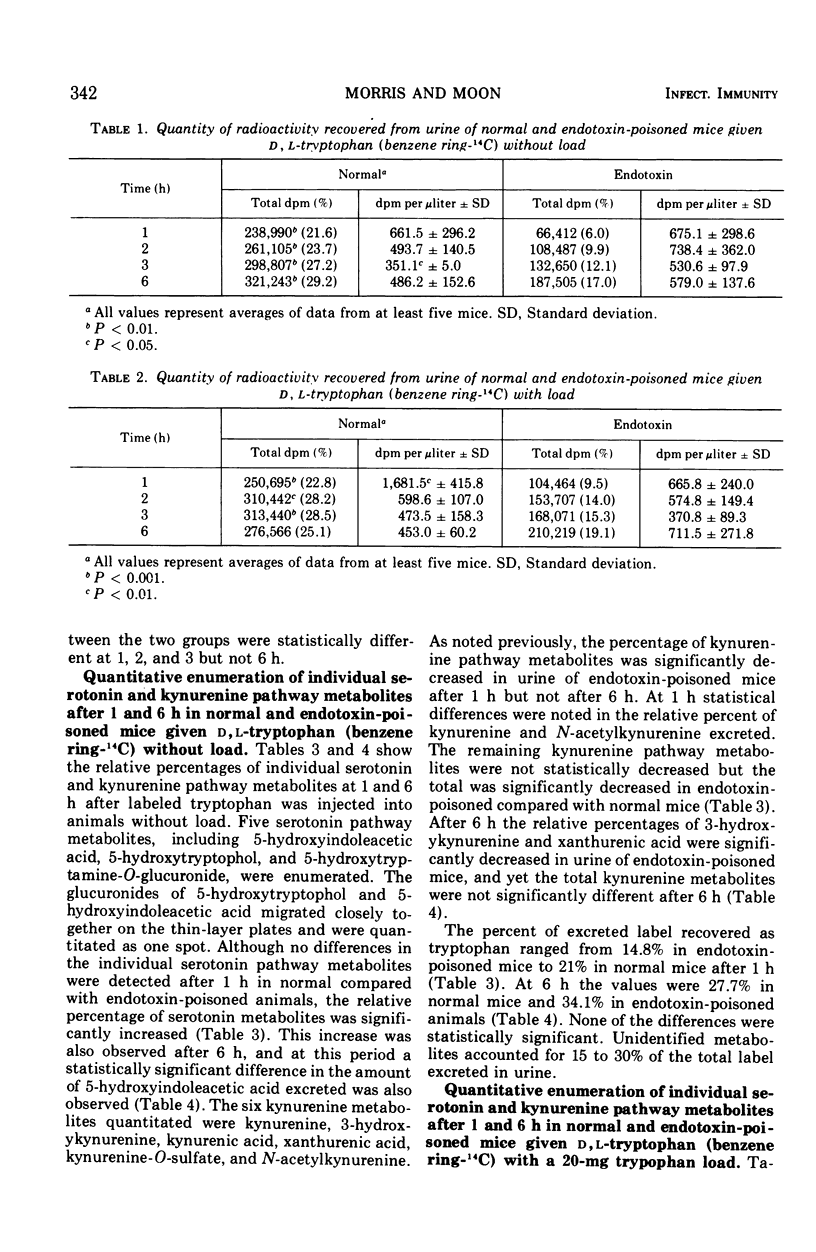Abstract
Endotoxin-poisoned mice converted significantly greater quantities of tryptophan to serotonin than did normal mice. The percentage increase, approximately 10 to 15%, was the same whether mice were given only trace quantities of tryptophan or tryptophan load (20 mg of l-tryptophan). The increased serotonin synthesis was accompanied by a decreased flow of tryptophan into the kynurenine pathway. These results indicate that excess serotonin synthesis occurs not only at dose levels of tryptophan which are toxic for endotoxin-poisoned mice but also at physiological levels of tryptophan. This latter observation may have some importance in the overall pathophysiology of endotoxin shock.
Full text
PDF






Selected References
These references are in PubMed. This may not be the complete list of references from this article.
- BERRY L. J., SMYTHE D. S. EFFECTS OF BACTERIAL ENDOTOXINS ON METABOLISM. VI. THE ROLE OF TRYPTOPHAN PYRROLASE IN RESPONSE OF MICE TO ENDOTOXIN. J Exp Med. 1963 Oct 1;118:587–603. doi: 10.1084/jem.118.4.587. [DOI] [PMC free article] [PubMed] [Google Scholar]
- Burtis C. A., Goldstein G., Scott C. D. Fractionation of human urine by gel chromatography. Clin Chem. 1970 Mar;16(3):201–206. [PubMed] [Google Scholar]
- Burtis C. A., Warren K. S. Identification of urinary constituents isolated by anion-exchange chromatography. Clin Chem. 1968 Apr;14(4):290–301. [PubMed] [Google Scholar]
- Chen N. C., Gholson R. K. An improved column chromatographic method for isolation of tryptophan metabolites. Anal Biochem. 1972 May;47(1):139–145. doi: 10.1016/0003-2697(72)90287-4. [DOI] [PubMed] [Google Scholar]
- DONALDSON R. M., Jr, MALKIEL S., GRAY S. J. Serotonin studies on mouse tissues. Proc Soc Exp Biol Med. 1960 Feb;103:261–263. doi: 10.3181/00379727-103-25481. [DOI] [PubMed] [Google Scholar]
- Dalgliesh C. E., Horning E. C., Horning M. G., Knox K. L., Yarger K. A gas-liquid-chromatographic procedure for separating a wide range of metabolites occuring in urine or tissue extracts. Biochem J. 1966 Dec;101(3):792–810. doi: 10.1042/bj1010792. [DOI] [PMC free article] [PubMed] [Google Scholar]
- Des Prez R. M., Bryant R. E. Effects of bacterial endotoxin on rabbit platelets. IV. The divalent ion requirements of endotoxin-induced and immunologically induced platelet injury. J Exp Med. 1966 Nov 1;124(5):971–982. doi: 10.1084/jem.124.5.971. [DOI] [PMC free article] [PubMed] [Google Scholar]
- Hankes L. V., Brown R. R. Metabolism of D- and L-kynurenine-keto-14C in rats and the effects of unlabeled enantiomers. Proc Soc Exp Biol Med. 1968 Oct;129(1):144–153. doi: 10.3181/00379727-129-33271. [DOI] [PubMed] [Google Scholar]
- McISAAC W. M., PAGE I. H. The metabolism of serotonin (5-hydroxytryptamine). J Biol Chem. 1959 Apr;234(4):858–864. [PubMed] [Google Scholar]
- Moon R. J., Berry L. J. Effect of tryptophan and selected analogues on body temperatur of endotoxin-poisoned mice. J Bacteriol. 1968 Mar;95(3):764–770. doi: 10.1128/jb.95.3.764-770.1968. [DOI] [PMC free article] [PubMed] [Google Scholar]
- Moon R. J., Berry L. J. Role of tryptophan pyrrolase in endotoxin poisoning. J Bacteriol. 1968 Apr;95(4):1247–1253. doi: 10.1128/jb.95.4.1247-1253.1968. [DOI] [PMC free article] [PubMed] [Google Scholar]
- Moon R. J., Tremblay E. S., Morris K. M. Distribution and metabolism of 14C-tryptophan in normal and endotoxin-poisoned mice. Infect Immun. 1973 Oct;8(4):604–611. doi: 10.1128/iai.8.4.604-611.1973. [DOI] [PMC free article] [PubMed] [Google Scholar]
- Moon R. J. Tryptophan oxygenase and tryptophan metabolism in endotoxin-poisoned and allopurinol-treated mice. Biochim Biophys Acta. 1971 Feb 23;230(2):342–348. doi: 10.1016/0304-4165(71)90221-2. [DOI] [PubMed] [Google Scholar]


